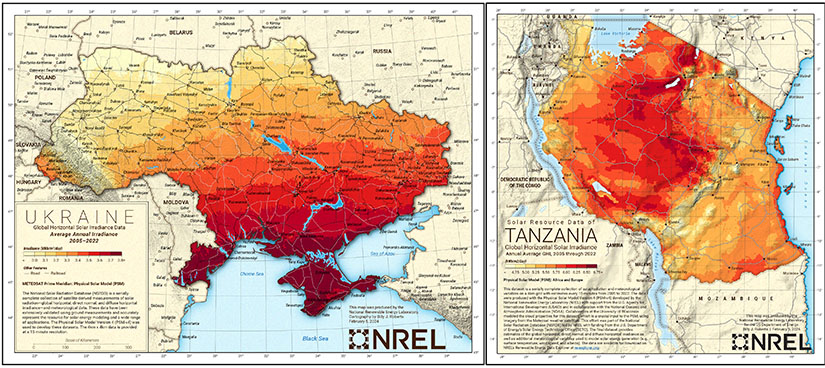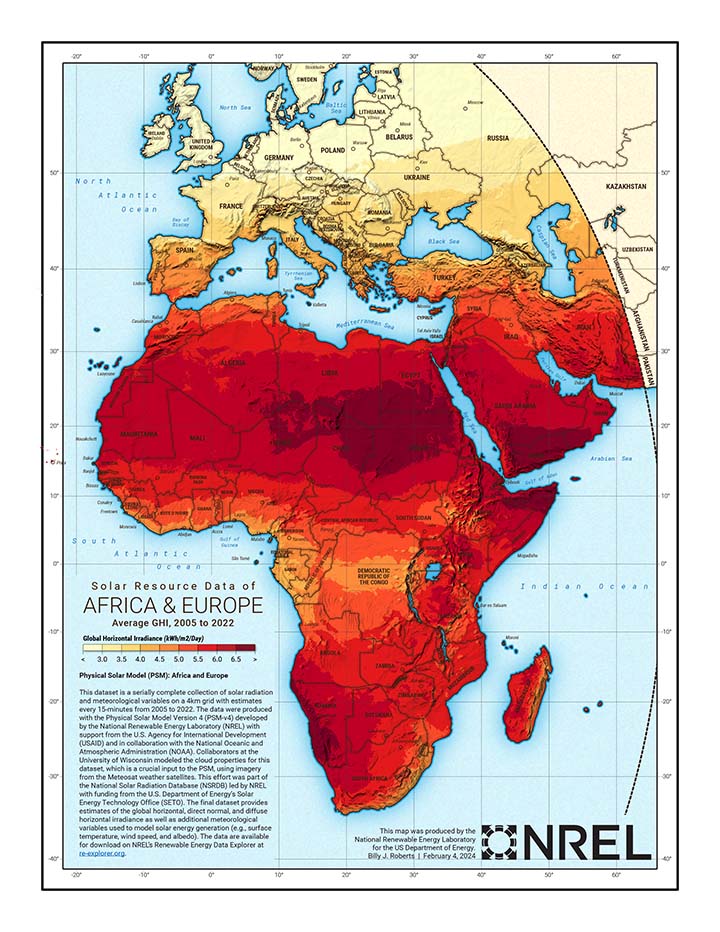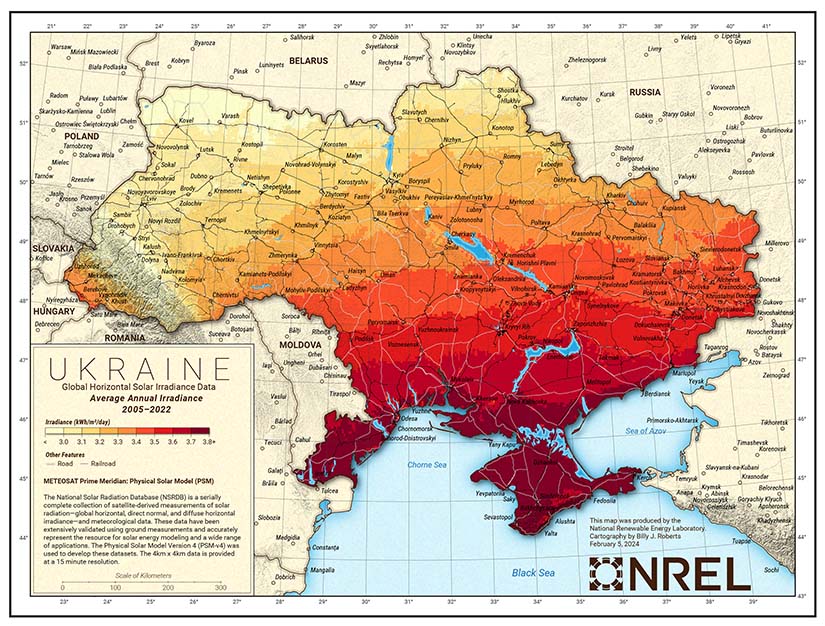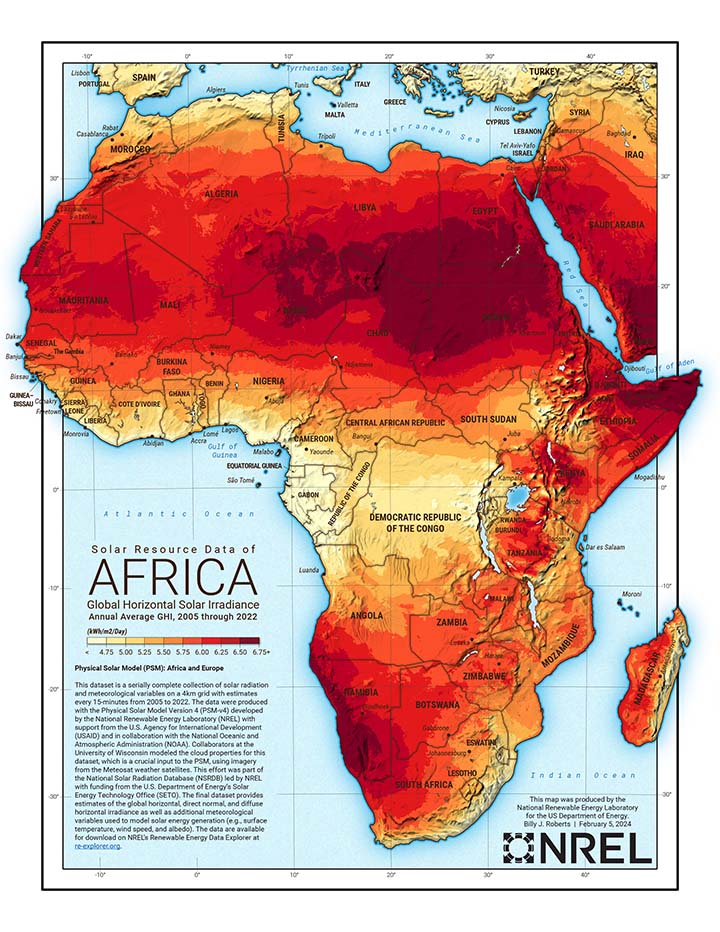Sign up for daily news updates from CleanTechnica on email. Or follow us on Google News!
New High-Resolution Solar Data and Analysis Provides In-Depth Look at Solar Resources in Africa, Eastern Europe, and the Middle East
Over 20 years of research in solar radiation at the National Renewable Energy Laboratory (NREL) is now poised to advance power system planning and solar energy deployment across Africa, Eastern Europe, and the Middle East. It comes in the form of a new, high-resolution solar timeseries data set on the Renewable Energy Data Explorer (RE Data Explorer) tool, tailored to the needs of stakeholders in energy sectors across national governments, academia, and private industry.

Development of the data set was motivated by the unique challenges facing two countries working with NREL and the U.S. Agency for International Development (USAID): Tanzania and Ukraine. In both countries, the availability of reliable, long-term resource data is a barrier in accelerating the deployment of renewable energy. In Ukraine, planners are working to find ways to rebuild and decentralize a grid that has been crippled by Russia’s full-scale invasion. And in Tanzania—as is the case with many countries in Africa—reliable, detailed data has been historically difficult to access for planners and developers alike.
Partnering Through USAID for a Clean Energy Future

“I always admire the kind of support USAID provides to our partner countries because I don’t see who else is going to do it,” NREL’s Tanzania technical lead Kwami Sedzro said. “If they did not provide that funding to help these countries and actually get their hands dirty on these challenges that the grid is facing now and will be facing with more renewables tomorrow, these projects might not happen.”
Undertaking a project of this size required collaborative effort. The USAID Missions, or satellite offices, in Ukraine and Tanzania first worked with their partners at NREL to establish what the research and analysis priorities for each country would be. Based on those priorities, the team at NREL saw how this data set could address some of their overlapping needs.
“Rather than processing all of the data twice and splitting the regions, or just processing one region, it’s way more efficient to do it together,” NREL’s Ukraine program lead Ilya Chernyakhovskiy said. “This way, both regions benefit.”
Bird’s-Eye View: How the Data Is Collected and Disseminated
RE Data Explorer is a publicly available geospatial analysis tool that gives users the ability to access renewable energy data customized to their needs. Its data can feed into tools such as the System Advisor Model, PVWatts, and others that can inform ongoing and future analysis, policymaking, and power system planning. RE Data Explorer has thousands of dedicated users who have shared how its capabilities are instrumental in their clean energy project development, long-term energy planning, and academic research.
To produce this new data set, the researchers compiled data sources covering Africa, Europe, and the Middle East from 2005 through 2022. Using imagery captured every 15 minutes by the European Union’s (EU) Meteosat geostationary weather satellites, NREL’s partners at the University of Wisconsin modeled key factors like cloud cover and composition. NREL also integrated satellite data from NASA representing aerosols (such as smoke, dust, and other airborne particulates) to estimate the solar irradiance reaching the surface on a four-kilometer (km) grid.
“The path of solar radiation through the atmosphere is very complex,” Geospatial Data Science (GDS) group manager Galen Maclaurin said. “The most important component in modeling solar radiation as it reaches the surface is clouds. How thick are they? How high are they? What is the optical thickness? Are they formed mostly of liquid or frozen water, and what is the average particle size?”
The cloud properties are then run through NREL’s radiative transfer model—called the Fast All-sky Radiation Model for Solar (FARMS)—on the laboratory’s high-performance supercomputer, pixel by pixel, time step by time step, to create a high-resolution grid over the 18-year period of the final data set.
Having easy and free access to these robust data is vital for solar developers and potential purchasers of the electricity (e.g., a public utility) because it helps them estimate the expected amount of electricity generated for a given percentage of years of a project, which informs an important parameter called the exceedance probability.
“Those numbers are important because they’re used to inform project risk and help secure financing. To calculate exceedance probabilities, you need the long-term record of the solar resource to represent interannual variability, and this feeds into project bankability,” Maclaurin explained. “It provides an assessment of the generation potential and its uncertainty, and thus informs the project risk for a financier or a bank.”
Building Ukrainian Grid Resilience Through Renewable Energy
In Ukraine, planners and developers are looking to incorporate more renewable energy as the country rebuilds its grid and searches for new means to become less dependent on foreign resources.
“The focus is all about making the grid more resilient during the war and rebuilding,” Chernyakhovskiy explained. “One of the goals for the Ukrainian Ministry of Energy is to rely less on imports of natural gas and imports of diesel for backup generators. They hope to utilize domestic wind and solar resources while diversifying the geographic concentration of power system resources; that’s really where they’re interested in renewables right now.”
A major hurdle Ukraine faces, however, is easily accessible, accurate, detailed information on its wind and solar output capabilities. Chernyakhovskiy said because Ukraine is not yet part of the EU, many of the more detailed data sets for the EU do not include Ukraine. “It really helps with planning and understanding where the resources are—where it is most cost effective to build distributed resources that will help to decentralize the grid,” he explained.

Part of what makes grid planning in Ukraine difficult is the diversity of solar and wind resources and thus potential generation. The spatial and temporal variability of solar irradiance captured in this new data set, for example, gives planners and developers a clear picture of where they could competitively build photovoltaics (PV) as they work to decentralize the grid. This long-term, time series data set is vital in making new deployment a reality because it creates confidence in the analysis.
“It’s an enabler to help planners, utilities, and developers accelerate their adoption of renewables because they can skip the step of doing a site-by-site assessment of the resource,” Chernyakhovskiy said.
Beyond solar data, the USAID Ukraine Mission is interested in generating robust, long-term wind data as well. Using a novel methodology developed at NREL, a team in NREL’s Strategic Energy Analysis Center is creating a high-resolution data set by using artificial intelligence (AI) algorithms to downscale (or increase the spatial and temporal resolutions) of existing climate models. To do that, they train the AI model on high-resolution modeled data for the United States then apply it to lower-resolution climate data for Ukraine. This method builds on recent work by USAID and NREL’s Advanced Energy Partnership for Asia to produce high-resolution wind data for Southeast Asia.
“We’re pretty excited about applying that kind of state-of-the-art method to Ukraine, and that really gave us the ability to cover the whole country for such a long time series at such high resolution,” Chernyakhovskiy said.
The new Ukraine wind data will be released in the coming weeks on RE Data Explorer, followed by a webinar later this spring.
Making a Difference in Tanzanian Grid Planning

On the other side of the equator, the USAID Tanzania Mission is working to help the country achieve its own renewable energy goals. Currently, Tanzania is working toward decarbonizing its grid, with a 30–35% conditional emissions-reduction target by 2030, per Tanzania’s Nationally Determined Contributions in the United Nations Development Programme’s Climate Promise.
By making the new, long-term time series data set easy to access and freely available to the public, Tanzania and other African nations are better poised to accomplish their energy goals.
“This is a big deal to have a solar data set that we can trust for Africa; it’s going to be a game changer,” Sedzro said. “Providing these data is going to be very helpful for the industry as a whole in Africa, because then people can be motivated to invest in the technology.”
Sedzro is going to Tanzania in April to train planners, utilities, and developers in Tanzania and other African countries like Ghana to use the solar data set to effectively plan PV deployment.
“They’re able to see how much they can get out of the data, and they can do their math and decide whether they want to go here or there based on the solar time series data,” he explained. “You can see the irradiance values that you get today, and you can use that data to predict what’s going to happen tomorrow. You’re planning a system for tomorrow.”
Visit www.re-explorer.org to use the new data set and explore the site’s trainings, knowledge products, and resources.
By Tim Meehan. Courtesy of U.S. Department of Energy, NREL.
Have a tip for CleanTechnica? Want to advertise? Want to suggest a guest for our CleanTech Talk podcast? Contact us here.
Latest CleanTechnica TV Video
CleanTechnica uses affiliate links. See our policy here.





